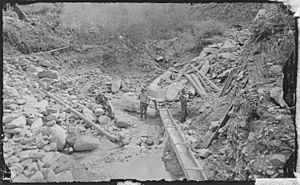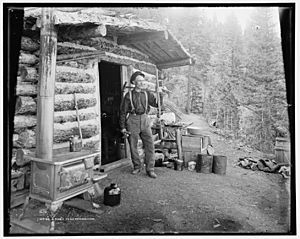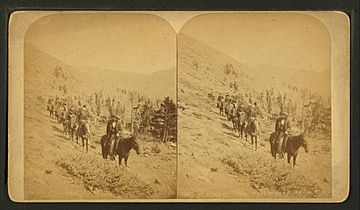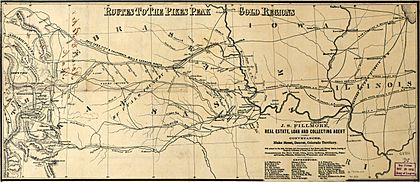Pike's Peak Gold Rush facts for kids
The Pike's Peak Gold Rush was a huge search for gold in the western parts of what were then the Kansas Territory and Nebraska Territory. It started in July 1858 and lasted until February 1861, when the Colorado Territory was created. About 100,000 people joined this exciting hunt for gold. It was one of the biggest gold rushes in North America.
People who took part in the gold rush were called "Fifty-Niners" because 1859 was the busiest year. Their famous saying was Pike's Peak or Bust! This meant they would either find gold near Pike's Peak or fail trying. Interestingly, most of the gold was found about 85 miles north of Pike's Peak. The rush was named after Pike's Peak because it was a very well-known mountain at that time.
Contents
What Was the Pike's Peak Gold Rush?
The Pike's Peak Gold Rush happened about ten years after the famous California Gold Rush. It brought a lot of people to the Pike's Peak Country in the Rocky Mountains. The slogan "Pike's Peak or Bust!" showed how determined people were to find gold. This mountain guided many early gold seekers as they traveled west across the Great Plains. These prospectors were the first large group of European-American people to settle in the area.
The gold rush led to the creation of several mining camps. Some of these camps, like Denver City and Boulder City, grew into important cities. Many smaller camps, such as Auraria and Saint Charles City, were later absorbed by bigger towns. Lots of other mining camps became ghost towns, but some, like Central City, Black Hawk, Georgetown, and Idaho Springs, are still around today.
How Gold Was Discovered
For many years, people thought the mountains in what is now Colorado might have a lot of gold. In 1835, a French trapper named Eustace Carriere got lost in the mountains. He found many gold pieces. He took them to New Mexico, where they were confirmed to be "pure gold." But when he tried to go back to the spot, he couldn't remember exactly where it was.
In 1849 and 1850, some gold seekers heading to the California Gold Rush found small amounts of gold. They used a method called placer mining in streams near the South Platte River at the base of the Rocky Mountains. However, this gold didn't seem as exciting as the gold in California. So, these discoveries were not widely reported for several years.
As the excitement of the California Gold Rush faded, many disappointed gold seekers went home. But rumors of gold in the Rocky Mountains continued. Several small groups explored the area. In the summer of 1857, a group of Spanish-speaking gold seekers from New Mexico found gold. They worked a placer deposit along the South Platte River. This was about 5 miles (8 kilometers) upstream from Cherry Creek, which is now part of Denver.

William Greeneberry "Green" Russell was from Georgia. He had worked in the California gold fields in the 1850s. Russell was married to a Cherokee woman. Through her, he heard about gold found along the South Platte River in 1849. Green Russell decided to organize a group to search for gold there. He set off with his two brothers and six friends in February 1858.
They met up with Cherokee tribe members along the Arkansas River in what is now Oklahoma. Then they continued west along the Santa Fe Trail. Other people joined them along the way, and their group grew to 107 people.
When they reached Bent's Fort, they turned northwest. On May 23, they arrived at the meeting point of Cherry Creek and the South Platte River. This spot is now Confluence Park in Denver. They started looking for gold in the riverbeds, including Cherry Creek and nearby Ralston Creek, but didn't find much.
In the first week of July 1858, Green Russell and Sam Bates made an important discovery. They found a small placer deposit near the mouth of Little Dry Creek. This spot gave them about 20 troy ounces (622 grams) of gold. This was the first significant gold discovery in the Rocky Mountain region. Today, this discovery site is in the Denver suburb of Englewood. It's just north of where U.S. Highway 285 and U.S. Highway 85 meet.
The First Gold Boom
The first ten years of the gold rush mainly focused on a few areas. These included the South Platte River at the base of the Rocky Mountains. Gold was also found in the canyon of Clear Creek west of Golden City. Other important areas were Breckenridge and South Park, near towns like Como, Fairplay, and Alma.
By 1860, Denver City, Golden City, and Boulder City had grown into large towns. They served as centers for the mining operations. The rapid increase in population led to the creation of the Colorado Territory in 1861.
The Pike's Peak Gold Rush made many Americans very excited. It caused them to pack their belongings and head to Colorado. This first boom also led to some people spreading false information. They would encourage others to go west without real proof of gold. As early as the spring of 1859, people rushed to the Pike's Peak area. Some even tried to go in the winter of 1858 to get a head start. But they soon realized they had to wait for the snow to melt before they could start mining.
Finding Gold in Rocks
Hardrock mining involves digging gold directly from rocks. This type of mining was very popular for a few years. However, it slowed down in the mid-1860s. Miners had dug out the easy-to-reach gold from the shallow parts of the rock veins. They then found that their mills could not get gold from the deeper, harder-to-process ores.
Colorado produced 150,000 ounces of gold in 1861 and 225,000 troy ounces in 1862. This success led the government to create the Denver Mint, where gold could be turned into coins. By 1865, Colorado had produced a total of 1.25 million ounces of gold. About 60% of this was placer gold, which is gold found in loose sand or gravel.
More About Gold Rushes
- Australian gold rushes
- Colorado Silver Boom
- Horace Greeley, a famous person who mined for gold in this rush
- Klondike Gold Rush
- Silver mining in Colorado
- Ute people
- Witwatersrand Gold Rush





